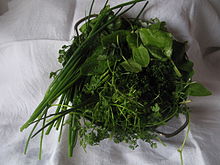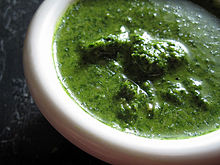Green sauce
This article needs additional citations for verification. (May 2020) |

Green sauce or greensauce is a family of cold, uncooked sauces based on chopped herbs, including the Spanish and Italian salsa verde, the French sauce verte, the German grüne Soße or Frankfurter grie Soß (Frankfurt dialect), the British mint sauce and greensauce, and the Argentinian chimichurri.[1]: 354
The Mexican salsa verde, though also called a "green sauce", is instead based on tomatillos and is commonly cooked; the New Mexico version uses a green chile base.
History
Green sauce has a long history in many parts of Europe. It was certainly present in the Middle Ages, and may date to the Classical period.[1]: 354
Green sauce made with parsley and often sage was one of the most common sauces of medieval cookery. In a 14th-century recipe, green sauce served with a dish of cheese and whole egg yolks boiled in watered down wine with herbs and spices was recommended for "lords, for settling their temperament and whetting their appetite".[2]

The basic recipe is probably from the
A possible origin of the German variant are
Ancient Rome
The Apicius (5th century CE) mentions a Ius viride in avibus ('Green sauce for fowl') consisting of pepper, caraway, spikenard, cumin, bay leaves, a variety of green herbs, dates, honey, vinegar, wine, broth, and oil.[3]: 147
Spain
In Spain, salsa verde usually refers to a fish sauce. The sauce is prepared using a base made of garlic and onion
Italy

The Italian salsa verde is a cold rustic sauce, and includes parsley, vinegar, capers, garlic, onion, anchovies, olive oil, and possibly mustard. The ingredients are coarsely chopped, formerly by hand, now often in a food processor. In some regions, cubed bread is soaked in vinegar and blended with the other ingredients, which creates an emulsion somewhat similar to a vinaigrette. In other regions, there is no bread.
Salsa verde is used as a condiment or dipping sauce for meats, fish, poultry, or vegetables. Salsa verde served with bollito misto in Piedmont and Lombardy is a "classic meat dish" served in many city and country restaurants.[5]: 15, 60, 63 The salted lake sardines from the Lake Como, called misoltini, are warmed or grilled and served with salsa verde.[5]: 78 It is also served with other grilled or stewed fish. A salsa verde with garlic, called agliata, is a traditional specialty of the Siena region on the feast day of Saint John.[5]: 277
Gremolata is a green sauce in Milanese cuisine based on parsley, lemon peel, and garlic, and is the usual accompaniment for ossobuco.[6]: 36
France
The French sauce verte au pain was already known in the
Germany


Grüne Soße is a specialty of the German state of
The hard-boiled eggs are sieved or pureed before being mixed with
The sauce is served cold with peeled boiled potatoes or just with rye bread, as an accompaniment to either hard-boiled eggs or roast beef brisket. It may also be served with cooked fish or roast beef, or as a side dish to barbecue. A local
The local importance of the dish is shown by the abundance of green sauce at local markets and by the Green Sauce Monument installed in Frankfurt-Oberrad in 2007. The latter consists of seven small greenhouses with the main herbal ingredients and was part of the Luminale, a local art and light event. The geographical indication (GI) "protected geographical indication (PGI)" was awarded to the fresh herb composition by the European Union on 9 March 2016;[9] publication of the detailed application with the product specification dated October 2015.[10]
In many Hessian families, Green Sauce is part of the traditional meal eaten on Maundy Thursday, relating to its German name Gründonnerstag (lit. 'Green Thursday').
Britain
British greensauce is made of herbs, especially
Argentina
Chimichurri is a green sauce used in Argentina and other parts of Latin America, usually served on grilled meat.
See also
- Pesto
- Green goddess dressing – a salad dressing of green sauce with sour cream and mayonnaise
References
- ^ ISBN 978-0-19-280681-9.
- ISBN 978-1-84383-363-5.
- ISBN 978-0-486-15649-1.
- ^ Teodoro Bardají Mas, (1936), «La cocina de ellas», Madrid, receta:147.
- ^ ISBN 88-365-2940-2.
- ISBN 978-0-226-09183-9.
- ^ Peter Badenhop, Frankfurter Gerichte : Fünf Spezialitäten, die man probiert haben sollte (five inevitable dishes of Frankfurt) in: Frankfurter Allgemeine Zeitung dated 25. August 2021.
- ^ Note that dill is an absolute no-go for the Frankfurt version. This is shown by slogans like "kill dill" (yes, a pun on the movie "Kill Bill", e.g. "...there is one iron rule about Grüne Soße – it should never contain dill, because its flavor is overpowering and it would disturb the fine balance of the other herbs. The Grüne Soße Festival has capitalized on this and sells cutting boards and T-shirts with the English slogan, "Kill Dill"." https://spoonfulsofgermany.com/2014/06/20/my-german-herb-garden/.
- ^ Eintrag zu Frankfurter Grüne Soße / Frankfurter Grie Soß in der Database of Origin and Registration (DOOR) der Generaldirektion Landwirtschaft und ländliche Entwicklung der Europäischen Kommission.
- ^ Publication of an application pursuant to Article 50(2)(a) of Regulation (EU) No 1151/2012 of the European Parliament and of the Council on quality schemes for agricultural products and foodstuffs
